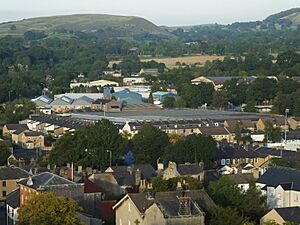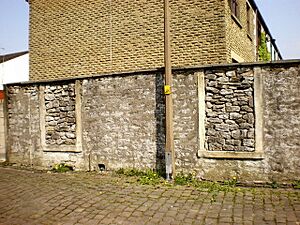List of mills in Clitheroe facts for kids
Clitheroe in Lancashire, England, is a town known for digging up limestone. But did you know it also had a big role in making cotton? For many years, Clitheroe was home to several busy cotton mills. These mills were like giant factories where raw cotton was turned into thread and fabric. They were a very important part of the town's history and economy.
Contents
Cotton Mills of Clitheroe
Clitheroe had many cotton mills that helped the town grow. These mills created lots of jobs and even led to new communities being built. Let's explore some of the most interesting ones.
Brewery Mill
The Brewery Mill has a cool history! It started as a brewery in 1788, making drinks. Later, it changed into a printworks in 1809, where patterns were printed on fabric. By 1834, it became a large spinning mill with weaving sheds. This means it made both thread and cloth. Sadly, the mill burned down in 1896, but it was rebuilt. Today, it's used as a furniture warehouse and has shops.
Holmes Mill
Holmes Mill was a very busy place. It was a complex mill that did many things. Workers here spun cotton into thread, wove thread into fabric, and even printed designs on cloth. Parts of the mill were built in 1823 and the 1830s. Offices and warehouses were added in 1843, and more weaving sheds in 1853. At its busiest, Holmes Mill had 16,000 spindles for spinning thread and 707 looms for weaving fabric!
Jubilee Mill
Jubilee Mill was built in 1887. It had large, single-story stone buildings where power looms wove fabric. There was also a special building for the steam engine and a tall brick chimney. Today, a company called Trutex uses this mill. They are famous for making school uniforms.
Low Moor Mill
Low Moor Mill was one of the earliest mills in Clitheroe. The first spinning mill opened in 1782. It was so important that it helped create a whole new village called Low Moor, Lancashire. By 1928, when the mill closed, the village had grown to include 200 houses, nine shops, a school, and churches. The mill used power from three large iron waterwheels, which got water from the River Ribble. It also used steam engines to help power the machinery.
Primrose Mills
Primrose Mills also had a long history of changes. It started as a spinning mill in the late 1700s. In 1810, it became a calico printworks, where colorful designs were added to fabric. Later, it was used for bleaching and dyeing fabrics. A new spinning mill was added in 1860. The mill site still has a mill-pond and a mill-lodge, which are small lakes fed by the Mearley Brook.
Salford Bridge Mill
Salford Bridge Mill was built between 1833 and 1860. It had both weaving sheds and a spinning mill. The name 'Salford' means 'the ford between willows,' which was a place where the main road crossed the Mearley Brook. The weaving sheds at this mill stayed open until 2006. Now, a Sainsburys supermarket stands on the site.
Victoria Mill
Victoria Mill was another important cotton mill in Clitheroe. However, this mill is no longer standing. It was demolished, and now houses have been built where the mill once stood. This shows how some of the old industrial sites have changed over time.
Waterloo Mill
Waterloo Mill was another mill that played a part in Clitheroe's cotton industry.
See also
- Category:Lists of textile mills in the United Kingdom
- List of mills owned by the Lancashire Cotton Corporation Limited
- List of mills in Lancashire






